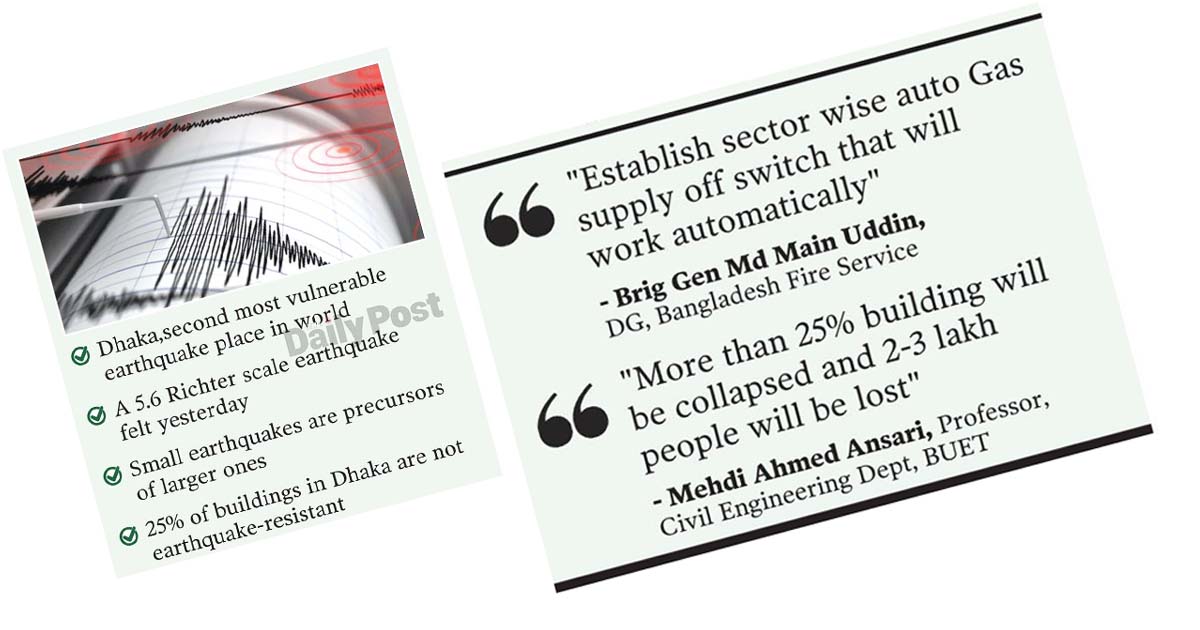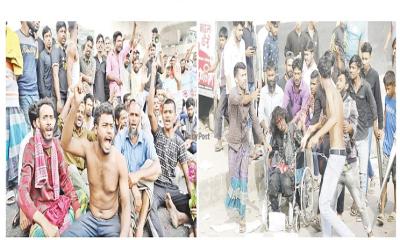Earthquakes of magnitude 7 to 8 can occur anytime in the country. Researchers say that if there is a major earthquake, the residents of the capital will suffer a lot of damage. Researchers think that 80 percent of the capital's buildings will be destroyed like the earthquake that happened in Turkey. A study by Bangladesh University of Engineering and Technology (BUET) also revealed the same. According to the research source, small and moderate earthquakes show signs of a tendency to release large amounts of energy. This means that a major earthquake can occur at any time. However, when this big earthquake will happen, cannot be said. A 5.6 Richter scale earthquake was felt at 9:35 am yesterday. Due to this, earthquakes were felt in different parts of the country including the capital. Sources from the Bangladesh Meteorological Department said that the magnitude of the earthquake was 5.6. It is initially known that its place of origin is in Ramganj of Lakshmipur. According to the United States Geological Survey Agency (USGS), the origin of the earthquake is 8 km east-north-east of Ramganj upazila of Lakshmipur.
Bangladesh has become increasingly prone to earthquakes. Occasionally, the country shakes with small and medium earthquakes. Although there is not much damage in these earthquakes, experts are afraid of massive damage in large-scale earthquakes. Yesterday, two hundred garment workers were injured when they rushed down to Amir Shirt Garments in Chouddagram of Cumilla due to the earthquake. A student of Dhaka University was injured after jumping from the window of the residential hall due to the earthquake. Later he was admitted to Dhaka Medical College Hospital. Moreover, cracks have appeared in the walls of five residential halls in Cumilla University (CoU). This has created panic among the students. But no damage was done. Dhaka ranks second among the 20 most earthquake-prone cities in the world. 56.26 percent of Dhaka's concrete buildings are at high risk. And 36.87 percent of buildings are at medium risk. These buildings will be damaged if there an earthquake of magnitude seven to eight on the Richter scale. Brigadier General Md Main Uddin, Director General of Bangladesh Fire Service & Civil Defense told The Daily Post that we have a severe lack of light rescue equipment. "We have enough manpower because when the emergency occurs, military people will also join us. But we are anxious about the Gas line and a gas fire/explosion will disturb the rescue work on top of doing further damage. As we worked in the Adamji Jute Mill for fire protection recently, we have come to realize the lack of gas section. Our gas division does not have the proper mapping and stop switch to halt supply when necessary."
He said, "We should establish sector-wise auto Gas supply off switch that will work automatically when heavy shake incoming." Mehdi Ahmed Ansari, Professor of the Civil Engineering Department of Bangladesh University of Engineering and Technology (BUET) said to The Daily Post, "There are 21 lakhs structures in Dhaka, 6 lakhs of which are building up to 6 floors. In 1897, there was a big earthquake in Dhaka city. We lost 10 houses and lost 15 people among the 90000 inhabitants of Dhaka in that earthquake. So in comparison, this density and unplanned building will create a huge causality and disaster. Padma Bridge and Bangabandu Bridge are not protected against earthquakes of more than 8 magnitude and have no scientific explanation. Because we think of it as a PG value that is more than 0.2G it is not time to hypothetically imagine. We just say more than 25% of buildings will be collapsed and 2/3 lakh people will be lost if we do not take the necessary initiatives.
Md Ashraful Islam, the Urban Planner (Acting) of RAJUK confirmed in The Daily Post that RAJUK is going to set up a rescue plan to reduce the loss of the hazardous earthquake at Dhaka. He said we are going to add a new act into our policy so that we can check the old design, revisit the building, and permit Recto fitting to rebuild the old building. He ensured that RAJUK would start the program within the next three to six months.
He also suggested the citizens that not fear the structures of old Dhaka as those are made upon the hard soil compared to the new Dhaka. The old Dhaka buildings are a maximum of 2/3 floors and are not as dangerous as the multi-storied buildings which are made on sand or soft base. A joint survey by the Integrated Disaster Management Program (CDMP) and JICA in 2009 said that if an earthquake of magnitude 7 or more is felt in Dhaka, 72,000 buildings in the city will collapse and 135,000 buildings will be damaged. Seven million tons of concrete piles will be made.
According to BUET's survey conducted at various times, there are 13 lakh multi-story buildings in Dhaka, 3 lakh in Chattogram, and 1 lakh in Sylhet. 75 percent of these buildings are six stories or higher. In case of a magnitude 7 earthquake, these buildings and their occupants will suffer the most.
ARS.






